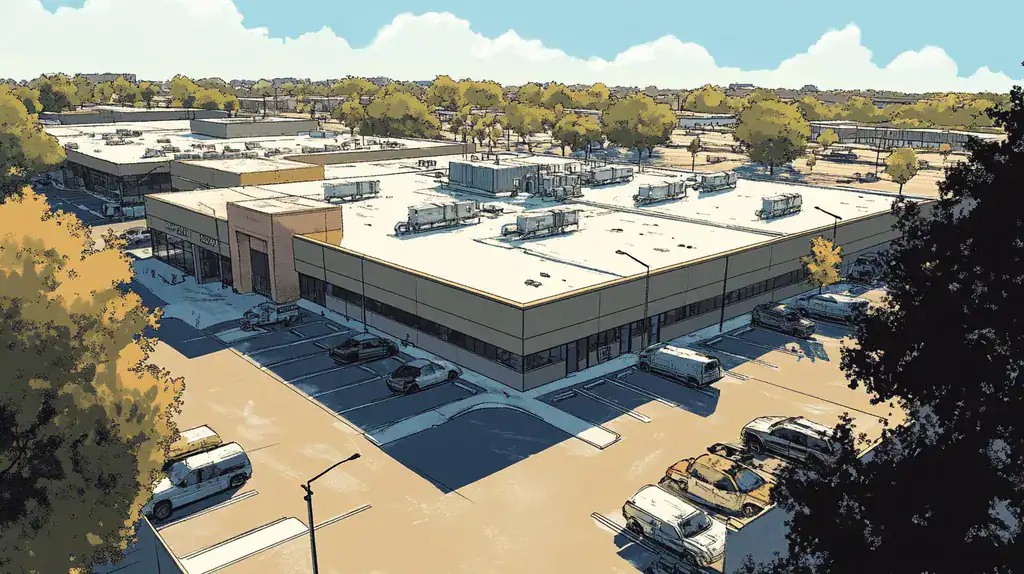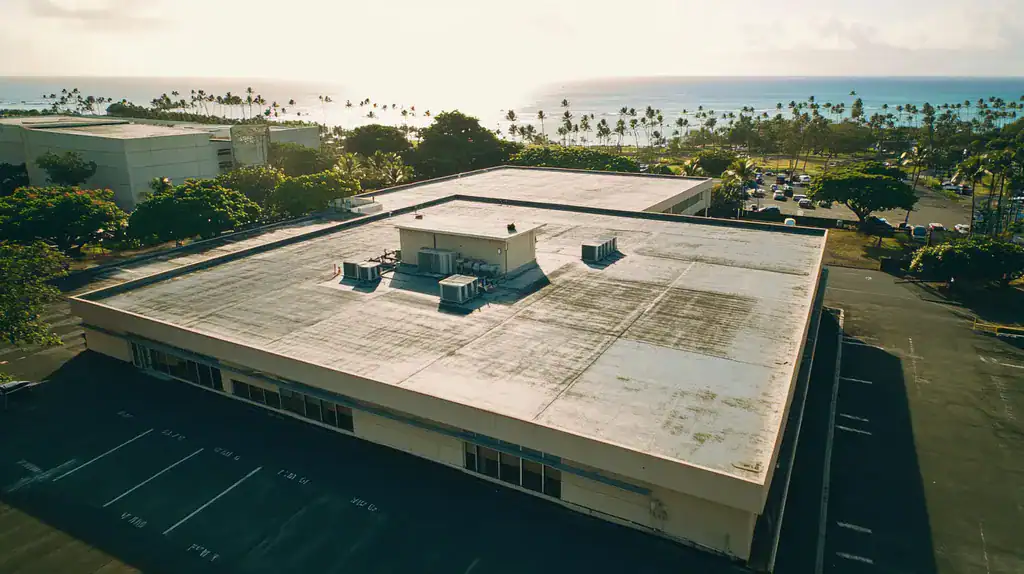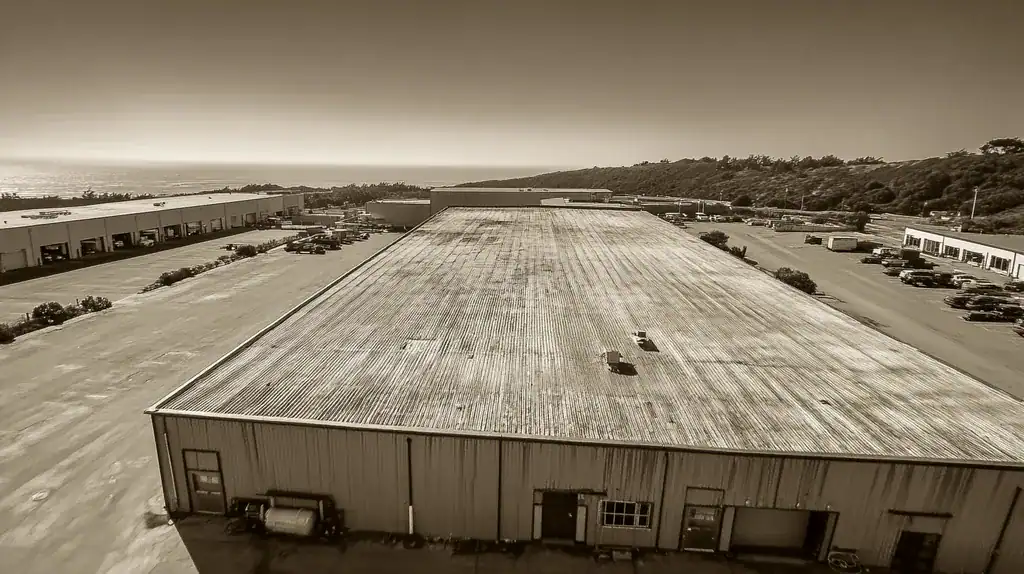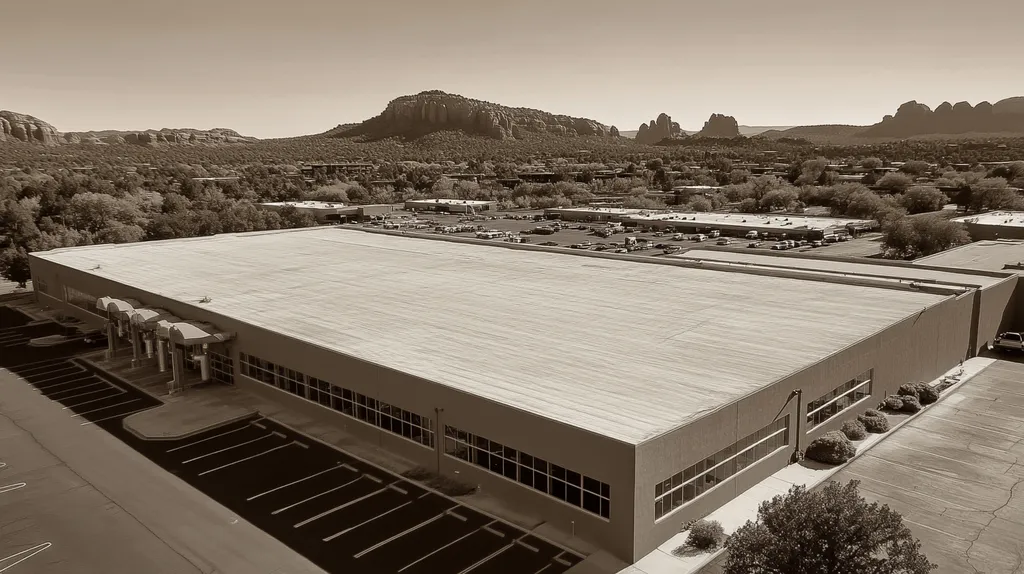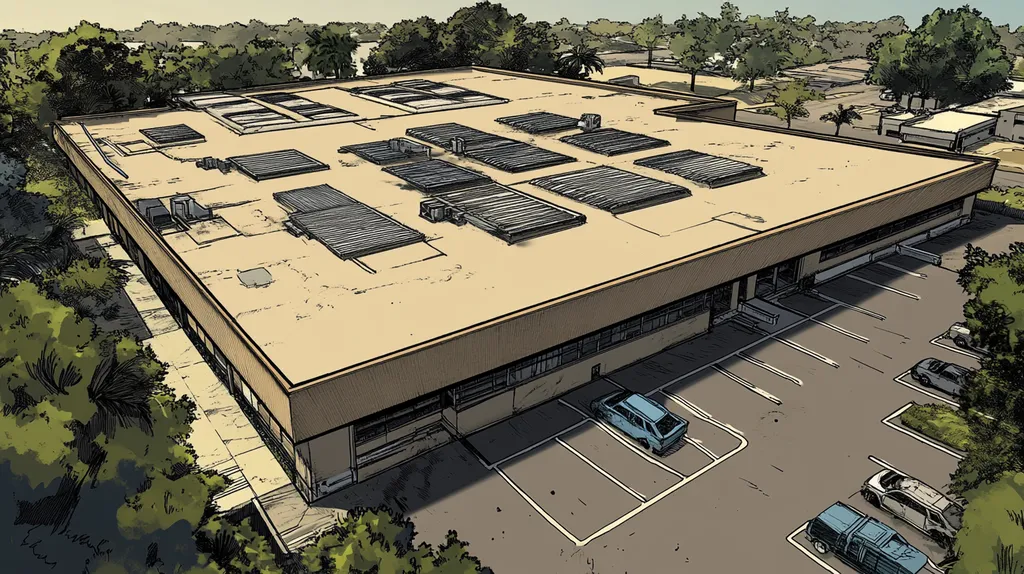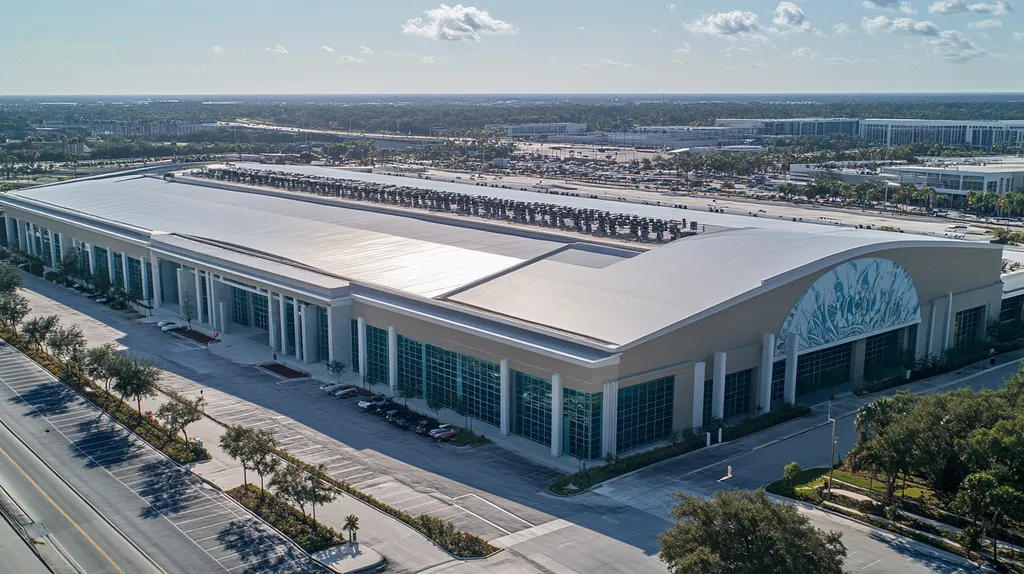Every year, commercial building owners lose millions in revenue and property damage due to preventable roof failures. Studies show that 80% of commercial roofs are replaced up to 7 years earlier than necessary due to inadequate preservation practices.
While proper maintenance can double a roof’s functional lifespan, most facility managers lack clear guidelines for implementing effective preservation strategies.
This comprehensive guide breaks down the essential elements of commercial roof preservation, from basic maintenance protocols to advanced lifecycle planning, helping property owners protect one of their most crucial building investments.
SECTION 1: THE BASICS EXPLAINED
Every year, commercial property owners lose millions of dollars due to premature roof failure and unnecessary replacements. Studies show that proper preservation can double a commercial roof’s functional lifespan, yet 80% of roofs are replaced years before necessary. Understanding and implementing effective preservation strategies isn’t just about maintaining a building component – it’s about protecting one of your property’s most substantial investments while avoiding catastrophic failures that can disrupt operations.
What It Is (In Plain Language)
Commercial roof preservation encompasses systematic procedures and practices that protect and extend your roof’s service life. It’s the difference between reactive maintenance – fixing problems after they occur – and proactive care that prevents issues from developing in the first place.
This approach includes regular inspections, preventive maintenance, and strategic repairs that address small issues before they become major problems. Think of it as healthcare for your roof system – regular check-ups and preventive care rather than emergency surgery.
A comprehensive preservation program monitors all aspects of roof performance, from membrane condition to drainage efficiency. It includes documenting changes, tracking repair history, and planning for future maintenance needs.
The goal is to maximize your roof’s performance while minimizing the total cost of ownership over its entire lifecycle. This means making smart, timely investments in maintenance rather than facing expensive emergency repairs or premature replacement.
Why It Matters (To Your Building)
Proper roof preservation directly impacts your building’s operational costs and asset value. A well-maintained roof prevents water infiltration that can damage expensive equipment, interrupt business operations, and create liability issues.
Energy efficiency heavily depends on roof condition. Deteriorated roofing materials and compromised insulation can increase heating and cooling costs by up to 40% compared to a well-maintained system.
Building occupants rely on roof integrity for comfort and safety. Poor roof conditions can lead to indoor air quality issues, structural concerns, and reduced workplace productivity.
From a financial perspective, every dollar spent on preventive maintenance can save four to five dollars in future repair and replacement costs. This makes preservation a crucial strategy for responsible asset management.
How It Works
Effective preservation starts with establishing baseline conditions through thorough inspection and documentation. This creates a reference point for tracking changes and planning maintenance activities.
Regular monitoring identifies developing issues before they become visible problems. This includes checking seams, flashings, drainage systems, and surface conditions during scheduled inspections.
Maintenance activities are scheduled based on roof type, age, and condition. These might include cleaning drains, resealing joints, addressing surface deterioration, or applying protective coatings.
Data collection and analysis help optimize the timing and scope of preservation activities. This ensures resources are allocated effectively and interventions occur at the most cost-efficient moments.
The program adapts over time as roof conditions change and new preservation technologies become available. This flexibility ensures the preservation strategy remains effective throughout the roof’s service life.
SECTION 2: PRACTICAL APPLICATIONS
Your commercial roof serves as your building’s first line of defense against wind, rain, hail, ice, and snow – yet it’s also the most vulnerable part of your building. Preservation practices directly impact both immediate protection and long-term performance. Understanding when and how to implement these practices, along with their relationship to other building systems, can mean the difference between a roof that fails prematurely and one that exceeds its expected lifespan. (source: Insurance Institute for Business & Home Safety)
Common Uses & Examples
Regular inspections form the foundation of effective preservation. These assessments should occur at least twice annually, with additional checks after severe weather events or when installing new rooftop equipment.
Surface treatments represent another crucial preservation strategy. Reflective coatings can reduce thermal stress while providing additional waterproofing protection, potentially extending roof life by 5-10 years.
Drainage maintenance requires consistent attention throughout the year. This includes cleaning gutters, ensuring proper slope to drains, and verifying that drainage paths remain unobstructed.
Seam reinforcement and flashing repairs prevent water infiltration at vulnerable transition points. These targeted interventions often prevent more extensive damage when properly timed.
When You Need It Most
Seasonal transitions demand specific preservation focus. Fall preparation should address drainage systems before winter precipitation, while spring assessments should evaluate any freeze-thaw damage.
Major equipment installations or modifications require careful coordination. Roofing professionals should inspect and reinforce areas around new penetrations or added weight loads.
Age-related milestones trigger increased preservation needs. Roofs typically require enhanced monitoring and maintenance as they approach the middle of their expected service life.
Environmental changes can accelerate deterioration rates. Areas experiencing increased severe weather events may need more frequent inspections and preventive treatments.
Interactions With Other Systems
HVAC operations significantly impact roof performance. Condensation from cooling units, vibration from equipment, and foot traffic during maintenance all require specialized preservation attention.
Building envelope integrity depends on proper roof-wall interfaces. These transition areas need regular inspection and maintenance to prevent air leakage and moisture infiltration.
Electrical systems, including lightning protection and solar installations, must integrate seamlessly with roofing components. Preservation practices should address potential wear points where these systems contact the roof surface.
Interior conditions can signal roof system problems. Monitoring indoor humidity levels and ceiling conditions helps identify potential roofing issues before they become severe.
SECTION 3: KEY TERMINOLOGY DECODED
Commercial roofing terminology can make the difference between protecting your investment and facing catastrophic failure. Studies show that misunderstandings about basic roofing terms lead to 35% of premature roof failures. When facility managers confuse terms like “membrane degradation” with normal aging, or mistake “positive drainage” for merely having roof slopes, the consequences can be severe structural damage and significant financial losses.
Essential Terms Explained
A roofing membrane serves as your building’s primary water barrier. Single-ply membranes like TPO and EPDM provide different benefits – TPO excels in heat reflection while EPDM offers superior durability in extreme temperatures.
Positive drainage means water flows completely off your roof within 48 hours after rainfall. Standing water beyond this timeframe, known as ponding, can add devastating weight loads and accelerate material breakdown.
Flashing systems protect the most vulnerable areas where your roof meets walls, pipes, or other structures. Proper flashing installation and maintenance prevent up to 95% of roof leaks.
The roof assembly includes all components from the deck up – insulation, cover board, membrane, and protective surfacing. Each layer plays a crucial role in system performance and longevity.
Industry Jargon Translated
R-value measures insulation effectiveness, with higher numbers indicating better thermal resistance. A roof’s required R-value varies by climate zone and building use.
Substrate refers to the surface directly under your roofing material. Identifying substrate issues early prevents hidden deterioration that can compromise entire roof sections.
Cap sheets provide the topmost layer in built-up roofing systems. These specialized materials offer UV protection and weather resistance while supporting foot traffic during maintenance.
Roof penetrations include any object passing through your roof membrane, from vent pipes to HVAC units. Each penetration requires specific flashing details to maintain watertight integrity.
Measurement & Units Simplified
A roofing square equals 100 square feet – the standard unit for material ordering and cost estimation. Understanding this basic measurement prevents costly ordering errors.
Slope ratings use a rise-over-run ratio, like 1:12 meaning one foot of height change per 12 horizontal feet. This measurement determines appropriate material choices and drainage characteristics.
Mil thickness describes membrane materials, with one mil equaling 1/1000 inch. A 60-mil membrane offers twice the material thickness of a 30-mil option, typically providing greater durability and puncture resistance.
Wind uplift ratings indicate how well your roof resists being pulled off by strong winds. These ratings, measured in pounds per square foot, must match your building’s location and height requirements for proper protection. (source: IBHS)
SECTION 4: DECISION FACTORS
Every commercial roofing decision carries long-term implications for building performance and operational costs. Studies show that 75% of roof failures stem from poor initial decisions rather than material defects or age-related wear. The choices made today – from material selection to maintenance protocols – determine whether a roof will protect your facility for decades or require premature replacement. Understanding these critical decision factors helps property owners avoid costly mistakes while maximizing their roofing investment.
Cost Considerations
Initial costs represent only 20-30% of total roof ownership expenses over a typical commercial roof’s lifespan. Smart investment decisions must consider lifecycle costs, including maintenance, repairs, and energy impacts.
Quality materials and professional installation may cost 15-25% more upfront but can reduce annual maintenance costs by up to 50%. These investments typically pay for themselves within 5-7 years through reduced repair needs and extended service life.
Emergency repairs cost 3-4 times more than planned maintenance. A proper maintenance budget should allocate funds for regular inspections and preventive care to avoid these costly reactive measures.
Energy costs tied to roofing choices can impact operating expenses by 25-35% annually. Investing in better insulation and reflective materials often delivers positive ROI through reduced HVAC demands.
Performance Trade-offs
Weather resistance and durability often compete with weight considerations and installation complexity. High-performance materials may require additional structural support or specialized installation techniques that impact project scope and cost.
Energy efficiency improvements through enhanced insulation must be balanced against moisture management needs. Thicker insulation packages can change roof dynamics and require careful attention to ventilation and vapor control.
Material longevity sometimes conflicts with initial cost constraints. While premium materials may last 20-30 years, budget options might require replacement in 10-15 years, making lifecycle cost analysis crucial.
System compatibility affects long-term performance. Choosing materials that work together as an integrated system often delivers better results than selecting individual components based solely on price.
Lifespan & Durability Factors
Local climate conditions significantly impact material selection and expected service life. Different regions require specific attention to factors like UV exposure, temperature extremes, and precipitation patterns that affect roof durability.
Building use patterns influence durability requirements. Facilities with heavy rooftop equipment traffic need enhanced protection, while buildings with minimal roof access may benefit from simpler systems.
Structural considerations affect lifespan potential. The building’s design, age, and condition must support the selected roofing system throughout its intended service life.
Regular inspections and maintenance protocols directly impact longevity. Properties implementing comprehensive preservation programs typically achieve 25-40% longer roof lifespans compared to reactive maintenance approaches. (source: Insurance Institute for Business & Home Safety)
SECTION 5: COMMON CHALLENGES
Commercial roof failures cost property owners billions annually in repairs, replacements, and business disruptions. Industry data shows that 90% of these failures stem from identifiable issues that could have been prevented through proper monitoring and maintenance. Understanding these challenges, recognizing early warning signs, and implementing preventive measures can help facility managers avoid catastrophic failures while maximizing roof performance and longevity.
Frequent Problems & Solutions
Membrane damage represents the leading cause of commercial roof failures. Impact from maintenance traffic, dropped tools, or storm debris can create tears and punctures that compromise the entire system’s integrity.
Poor drainage causes extensive damage through ponding water and ice formation. Blocked drains, inadequate slopes, and compromised drainage paths lead to accelerated material breakdown and potential structural issues.
Flashing failures account for nearly 80% of roof leaks. These critical transition points require proper installation and regular maintenance to prevent water infiltration at walls, equipment curbs, and penetrations.
Seam separation in single-ply systems creates vulnerable points for moisture entry. Regular inspection and prompt repair of failing seams prevents more extensive damage to insulation and deck components.
Warning Signs To Watch For
Surface blistering indicates trapped moisture within the roof system. These raised areas can rupture during temperature changes, creating entry points for additional water infiltration.
Membrane shrinkage manifests through pulled flashings and stressed seams. This condition typically worsens over time, requiring intervention before system failure occurs.
Interior staining or dripping may not align with actual leak locations. Water often travels significant distances within the roof assembly before appearing inside the building.
Regular inspections should occur at least twice annually and after severe weather events to identify potential issues before they become significant problems. Professional inspectors look for cracks, gaps, missing materials, and drainage issues during these crucial assessments. (source: American Weatherstar)
Preventative Approaches
Establishing dedicated maintenance pathways protects membrane surfaces from routine traffic damage. These walkway pads or protective covers channel movement to reinforced areas.
Regular debris removal prevents drain blockage and material degradation. This simple task significantly reduces ponding risks and extends system longevity.
Addressing small repairs promptly prevents moisture infiltration that can spread undetected through roof assemblies. Quick intervention often prevents more extensive and costly repairs.
Documentation of all roof activities, from inspections to repairs, helps track developing issues and optimize maintenance timing. This data-driven approach supports more effective preservation planning.
SECTION 6: NEXT STEPS & RESOURCES
Studies show that 65% of commercial roof failures stem from inadequate knowledge of proper maintenance protocols and industry standards. Each year, property owners waste millions on unnecessary repairs and premature replacements due to poor provider selection and maintenance oversights. Understanding how to evaluate service providers, interpret industry guidelines, and access ongoing education resources can mean the difference between a roof that fails prematurely and one that delivers decades of reliable protection.
Questions To Ask Providers
Start by verifying the contractor’s experience with your specific roofing system. Request detailed case studies and references from buildings with similar systems, age, and usage patterns to ensure relevant expertise.
Demand transparency about material specifications and installation methods. Quality contractors will explain why specific materials and techniques are recommended for your roof, backed by manufacturer data and performance metrics.
Review their quality control processes and documentation procedures. Professional providers maintain detailed records of inspections, repairs, and maintenance activities, enabling data-driven decisions about roof care.
Discuss emergency response capabilities and standard response times. Understanding how quickly a contractor can mobilize for urgent repairs helps prevent minor issues from escalating into major problems.
Industry Standards & Guidelines
Commercial roofs must meet specific performance criteria for wind resistance, drainage, and structural integrity. The Insurance Institute for Business & Home Safety outlines critical standards for protecting roofs against severe weather events, including proper edge reinforcement and penetration protection. (source: Insurance Institute for Business & Home Safety)
Familiarize yourself with ASTM International standards for roofing materials and installation practices. These guidelines ensure consistent quality and performance across all aspects of roof construction and maintenance.
Local building codes often exceed national standards based on regional climate conditions. Stay current with municipal requirements to avoid compliance issues that could void warranties or insurance coverage.
Energy codes increasingly impact roofing decisions through requirements for insulation values and reflective surfaces. Understanding these standards helps optimize both compliance and performance.
Further Learning Simplified
Professional organizations offer specialized certification programs focusing on commercial roof maintenance and preservation. These programs provide structured learning paths for understanding system components and maintenance requirements.
Technical bulletins from manufacturers and industry associations deliver regular updates on emerging technologies and best practices. Subscribe to these resources for ongoing education about roofing innovations.
Regional roofing associations host seminars and workshops addressing local challenges and solutions. These events offer valuable networking opportunities with experienced professionals.
Online platforms provide access to technical libraries, case studies, and discussion forums. These resources help property owners stay informed about evolving maintenance strategies and problem-solving approaches.
The Bottom Line
Commercial roof failures cost U.S. businesses over $2.5 billion annually in preventable damage, with 80% of roofs being replaced years before necessary due to inadequate preservation.
Effective preservation strategies can double a roof’s functional lifespan while reducing annual maintenance costs by up to 50%.
Regular inspections, proper drainage maintenance, and prompt repairs of minor issues prevent catastrophic failures that can shut down operations and damage valuable equipment.
By implementing comprehensive preservation guidelines, documenting maintenance activities, and working with qualified professionals, property owners can protect their roofing investment while avoiding the costly cycle of premature replacement.
The choice is clear: invest in preservation now or pay exponentially more for emergency repairs and early replacement later.
FREQUENTLY ASKED QUESTIONS
Q. What is commercial roof preservation?
A. Commercial roof preservation involves practices aimed at extending the roof’s lifespan. It includes regular inspections, proactive maintenance, and timely repairs. This approach minimizes the risk of premature failures and costly replacements.
Q. How often should you inspect an industrial roof?
A. Inspect your industrial roof at least twice a year. Additional inspections are crucial after severe weather events or when new equipment is installed. Regular assessments identify potential issues early and prevent serious damage.
Q. What does positive drainage mean for a commercial roof?
A. Positive drainage ensures that all water flows off your roof within 48 hours after rainfall. Standing water can lead to material breakdown and increased load on the roof structure, making effective drainage essential.
Q. How do seasonal changes affect industrial roofs?
A. Seasonal changes require specific preservation focus to accommodate weather impacts. Fall focuses on preparing drainage for winter, while spring assesses freeze-thaw damage. Understanding seasonal implications helps maintain rooves effectively.
Q. What are common causes of commercial roof failures?
A. Membrane damage, poor drainage, and flashing failures are leading causes of commercial roof failures. Regular inspections can prevent these issues. Proactive measures can drastically reduce risks of failures and expensive repairs.
Q. How can I choose a reliable roof maintenance provider?
A. Verify a provider’s experience with your specific roofing system. Request case studies and references to ensure their expertise. Transparency about materials, processes, and quality control is essential for building trust and ensuring quality service.
Q. What are the benefits of regular roof maintenance?
A. Regular maintenance extends roof life, reduces repair costs, and enhances energy efficiency. By identifying and addressing issues early, property owners can avoid costly emergent repairs. Regularly maintained roofs can last significantly longer than those neglected.

